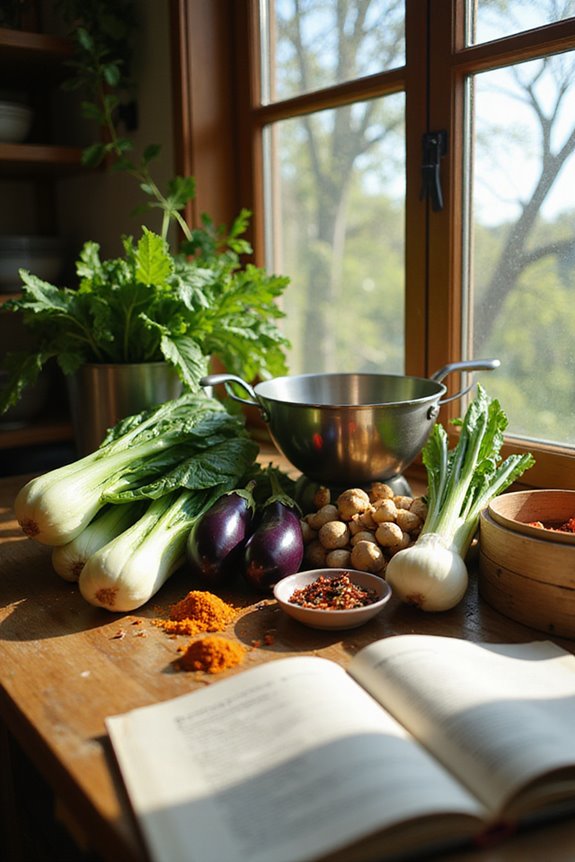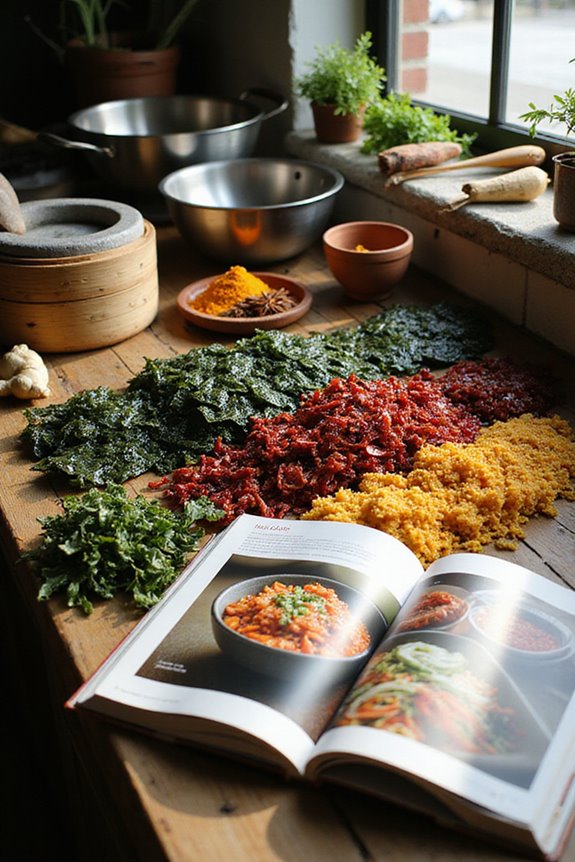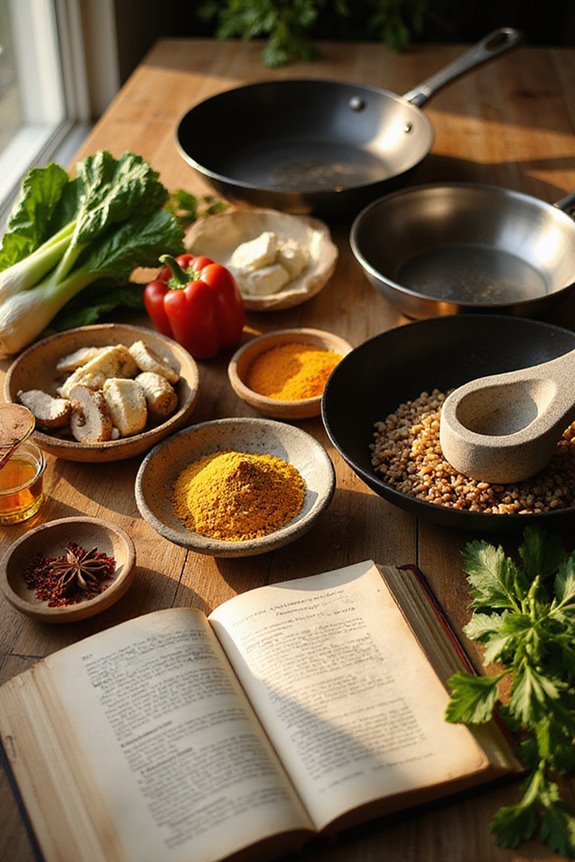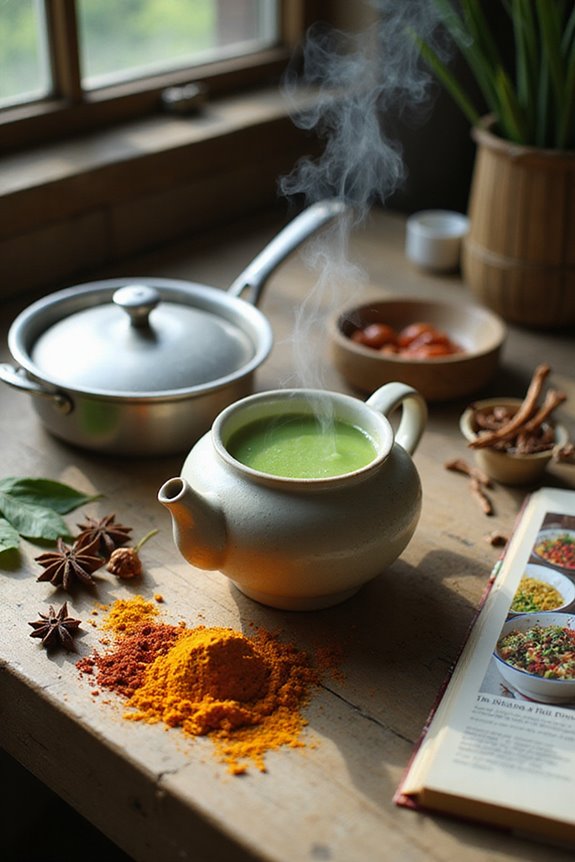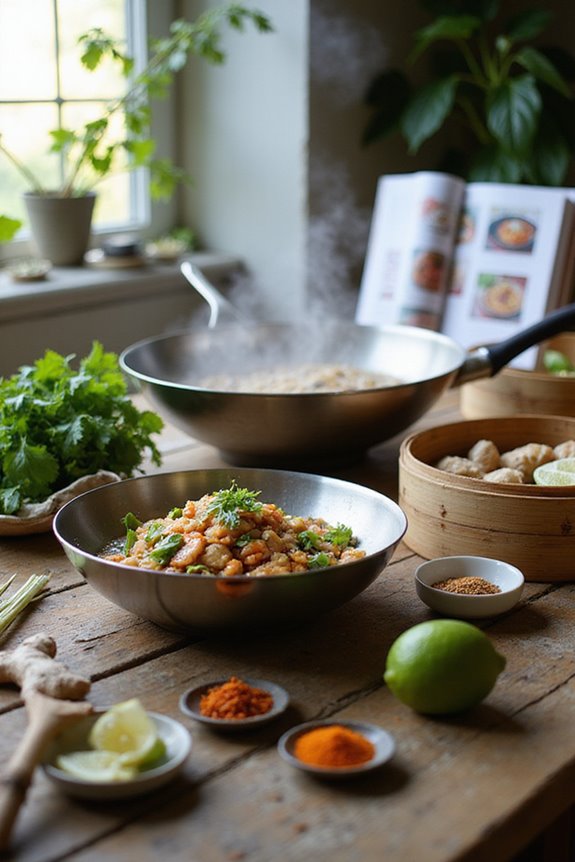Let’s explore some of the healthiest Asian vegetables that can truly elevate our meals! Bok choy, with just 20 calories per cup, is packed with vitamin C and calcium. Gai lan is antioxidant-rich and brings vibrant color to dishes, while choy sum offers a slightly sweet flavor for versatility. Don’t forget about lotus root‘s delightful crunch and bitter melon’s medicinal powers. If you’re excited about healthy cooking, there’s even more to uncover!
Key Takeaways
- Bok choy is low in calories and high in vitamin C and calcium, making it a nutritious choice for meals.
- Gai lan provides essential vitamins A, C, and K and is best cooked quickly to retain its nutrients.
- Choy sum is rich in vitamins A, C, and K, and its slightly sweet taste enhances various dishes when stir-fried or steamed.
- Lotus root offers a unique crunch, fiber, and vitamin C, while promoting immune health and versatile in different recipes.
- Bitter melon has insulin-like properties, aids in glucose reduction, and contains bioactive compounds that provide cancer-preventive effects.
Bok Choy: A Nutritional Powerhouse
Let’s plunge into the delightful world of bok choy! This magical vegetable packs a punch with its low calories and high nutrients. Just one cup has about 20 calories but delivers essential vitamins and minerals. We’re talking roughly 44 mg of vitamin C and 158 mg of calcium—talk about awesome bok choy benefits! Additionally, incorporating bok choy into our meals can enhance the overall nutritional information with its high content of fiber and antioxidants.
Here are a few tasty bok choy recipes we can try:
- Stir-fry with garlic and soy sauce: It’s super easy and always a hit!
- Bok choy soup: Perfect for a cozy evening, and it warms us up like a hug.
Gai Lan: The Antioxidant-Rich Green
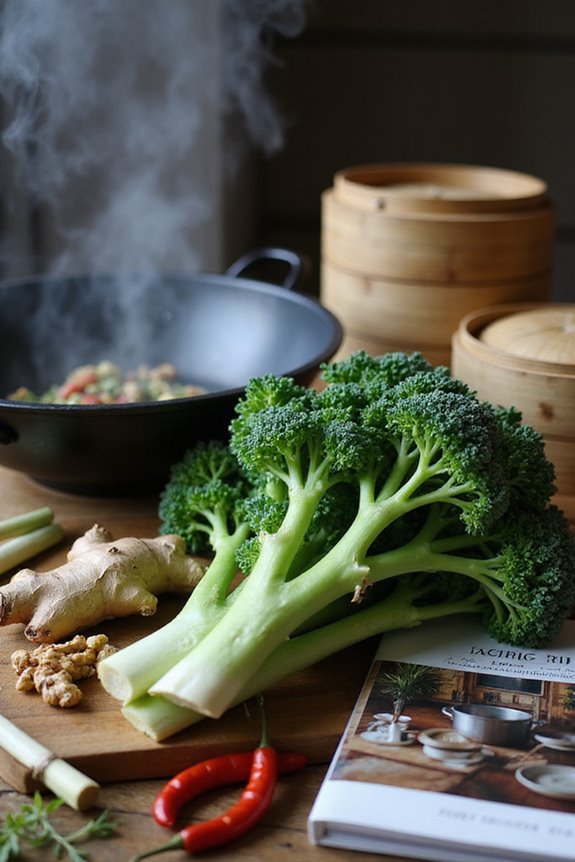
Gai lan, often crowned the “Antioxidant-Rich Green,” is an absolute star in the vegetable world! Packed with incredible gai lan benefits, this delightful veggie offers around 26 calories per 100 grams while brimming with vitamins A, C, and K. Just think—33% of your daily vitamin C needs in one serving!
For delicious gai lan recipes, simply stir-fry it with garlic and a drizzle of sesame oil for a magical side dish. Remember, overcooking can zap its nutrients, so a quick sauté is best. Additionally, incorporating organic ingredients like lemongrass can enhance the nutritional profile of your meals! With its bold flavor and vibrant green hue, gai lan is a wonderful addition to any meal. Let’s embrace this powerhouse veggie in our diets and enjoy its health-boosting benefits together!
Choy Sum: Sweet and Versatile
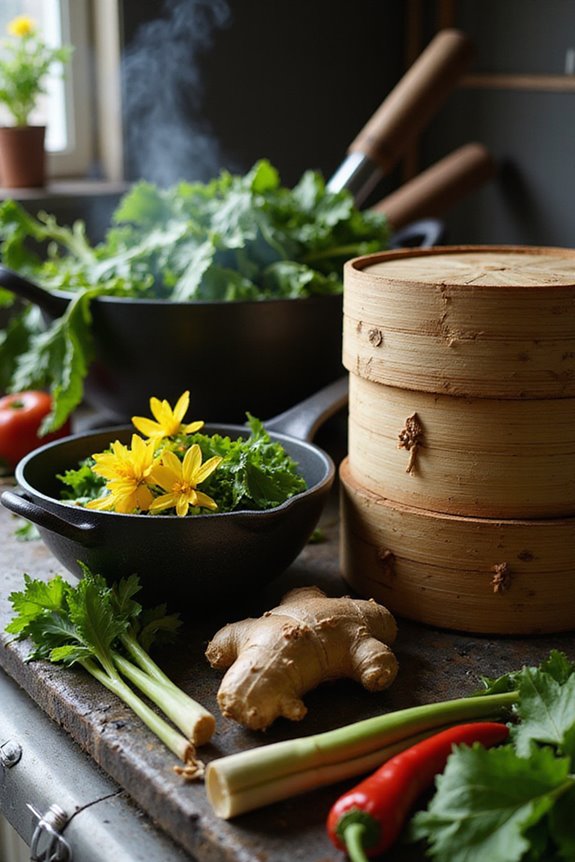
Choy sum is another delightful vegetable to include in our meals, especially if we loved the bold flavors of gai lan. Its tender stalks and dark green leaves make it incredibly versatile! We can enjoy it in various cooking methods, like:
- Stir-frying with garlic for a quick, flavorsome dish
- Steaming to keep its nutrients intact
- Tossing it into soups for an extra health boost
Among its many health benefits, choy sum is rich in vitamins A, C, and K, supporting our eyes, bones, and immune system. Plus, it brings a slightly sweet flavor to our plates. So next time you want to add a magical touch to your meal, let’s reach for this vibrant veggie! Additionally, when preparing choy sum, using a well-balanced knife can enhance your slicing and chopping efficiency.
Lotus Root: A Unique Root Vegetable
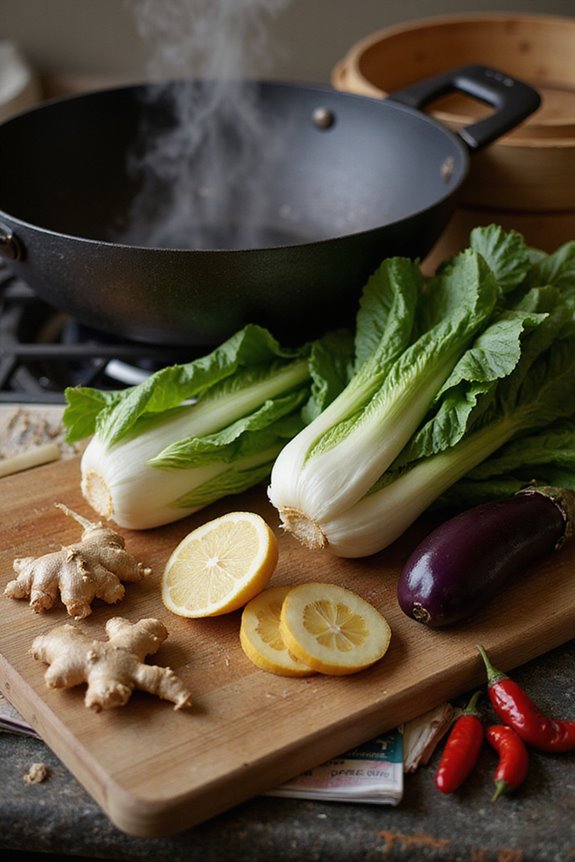
Lotus root is truly a magical vegetable that can add amazing texture and flavor to our meals! Packed with nutrients, its crunchy goodness is not just fun to eat but is also loaded with lotus root benefits. Each serving boasts 4.9 g of dietary fiber, which keeps our tummy happy and healthy. Plus, with 44 mg of vitamin C, it’s like a little immune booster during flu season!
We can enjoy lotus root in various delicious dishes. Try it in stir-fries or as a crunchy salad addition. Just slice it up, toss it into a pan, and watch it transform! Additionally, incorporating lower oil usage in your cooking can enhance the health benefits while embracing this delightful root veggie and experimenting with some lotus root recipes together! It’s a step towards healthier cooking!
Bitter Melon: A Medicinal Marvel
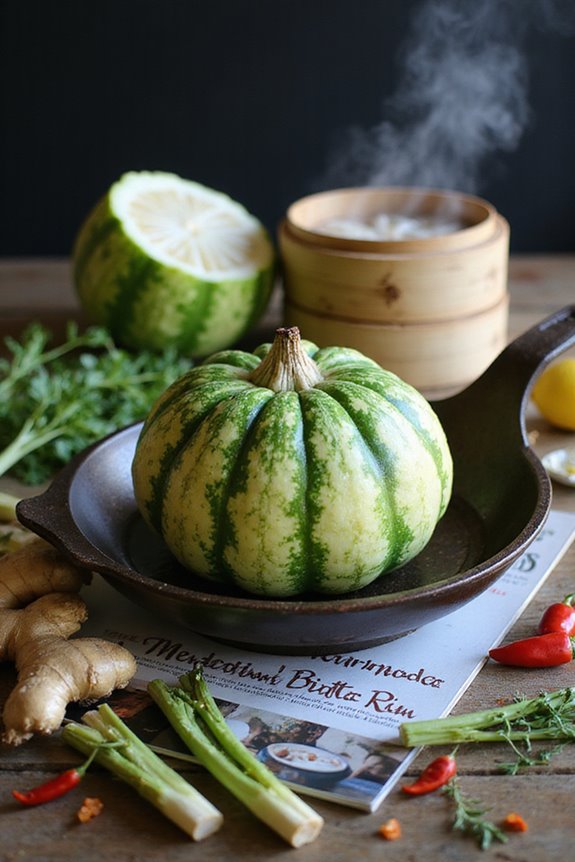
When we think of unique vegetables, bitter melon definitely stands out with its delightful charm and incredible health benefits! This magical fruit is a superstar for those managing blood sugar levels. Its insulin-like properties help lower glucose, making it a must-have for diabetes management.
But that’s not all—bitter melon shines in cancer prevention too! With bioactive compounds that inhibit cancer growth, it’s like armor for our cells. Plus, its high levels of antioxidants protect against oxidative damage.
Interestingly, it pairs well with air frying fish cakes, enhancing both texture and flavor in various dishes while contributing to a healthier lifestyle. Whether we enjoy it raw, as juice, or in stir-fries, let’s embrace bitter melon in our meals. It’s not just delicious; it’s a delightful addition to a healthy lifestyle. So, why not add some of this medicinal marvel to our plates today?
Napa Cabbage: Low-Calorie and Nutritious
Napa cabbage is like a magical green treasure waiting to be discovered! This delightful vegetable packs a punch with just 16 calories per 100 grams. It’s a real hero for our health, boosting immunity and supporting digestive health.
When we cook it—whether in stir-fries, soups, or salads—we’re not just enjoying tasty flavors; we’re also soaking up vitamins A, C, and minerals like potassium and calcium.
To keep those nutrients intact, remember to try steaming as a cooking method. Let’s embrace its versatility and include Napa cabbage in our meals for a heart-healthy, bone-boosting boost. Additionally, using a carbon steel wok helps to enhance the natural flavors of Napa cabbage while ensuring even cooking. So why not treat ourselves to this nutritious wonder? It’s the perfect addition to our culinary adventures!
Snow Peas: Crunchy and Colorful
Snow peas are a delightful burst of color and crunch that can elevate any dish! These little gems are not just pretty but pack a healthy punch with their snow pea benefits. They’re low in calories (just 30–42 per 100 grams) and rich in vitamin C, fiber, and folate.
Here are a few fun snow pea recipes to try:
- Stir-Fry: Toss them in a colorful stir-fry for a vibrant crunch!
- Salads: Add raw snow peas to salads for a delightful texture and freshness.
These crunchy pods also support heart health and digestion, which makes them magical for our well-being. So, let’s get cooking and enjoy the nutritional bounty that snow peas offer!
Edamame: Protein-Packed Snack
Edamame is like a magical little green pod bursting with potential! These delightful snacks are not just fun to eat; they’re packed with benefits. Each cooked cup offers about 18.5 grams of protein, 8 grams of fiber, and a treasure trove of vitamins like folate and minerals such as iron.
Here are some tasty ways to enjoy edamame:
- Boil or steam it simply for a quick snack.
- Toss it into salads for a protein boost.
- Create a creamy dip by blending edamame with garlic and lemon.
With something as versatile as edamame, we can all bring flavors to our plates while embracing these nutritious ideas! So let’s get cooking and make some magical edamame recipes together!
Frequently Asked Questions
How Can I Incorporate Asian Vegetables Into My Daily Diet?
Did you know that incorporating just one cup of Asian vegetables daily can boost our nutrient intake considerably? We can easily stir-fry them in quick recipes or explore vibrant salad combinations for a delicious, healthy meal.
Are Asian Vegetables Suitable for Vegan or Vegetarian Diets?
Absolutely, Asian vegetables fit perfectly in our vegan and vegetarian diets. Their nutrient density and rich plant-based sources provide essential vitamins and minerals, helping us thrive together on our plant-based journey toward better health.
What Are the Best Storage Methods for Asian Vegetables?
When it comes to storage techniques, we should always opt for the crisper drawer and use paper towels. Doing so really enhances vegetable longevity, ensuring our fresh Asian greens stay vibrant and delicious longer for all of us!
Can Asian Vegetables Be Eaten Raw, or Do They Need Cooking?
We can definitely enjoy Asian vegetables both raw and cooked! Raw consumption preserves nutrients, while various cooking methods enhance flavors and digestibility. Let’s explore these tasty options together for a balanced and delicious meal!
Are There Any Allergies Associated With Common Asian Vegetables?
As we explore the vibrant tapestry of Asian vegetables, we’re reminded that while allergy symptoms are rare, vegetable cross-reactivity can happen. Let’s celebrate diversity in our meals while staying mindful of our individual sensitivities.

